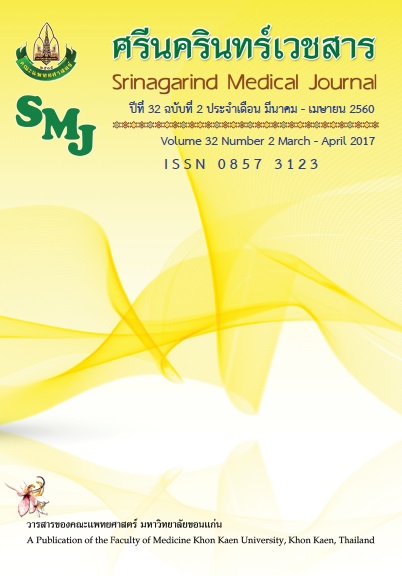Incidence of Ventricular Arrhythmia after Aortic Declamping During Mitral Valve Surgery: Comparison between the Use of Bretschneider-HTK and Cold Blood Cardioplegia
Keywords:
Cold blood cardioplegia, Bretschneider-HTK, Ventricular arrhythmia, สารละลายคาร์ดิโอพลีเจีย, สารละลายคาร์ดิโอพลีเจียชนิดผสมเลือด, หัวใจห้องล่างเต้นผิดจังหวะAbstract
Background and Objective: Ventriculararrhythmia is a common complication during declamping aorta in open heart surgery. Myocardial preservation during aortic clamping plays a major role in prevention of ventricular arrhythmia. Cardioplegia usage is one of the techniques to promote myocardial preservation.Cold blood cardioplegia solution is delivered repeatedly to coronary artery just after aortic clamping and every 20-30 minutes. Bretschneider-HTK, a newer solution is delivered once just after aortic clamp. In this study, we compared the incidence of ventricular arrhythmia after aortic de-clamping during mitral valve surgery between Bretschneider-HTK and cold blood cardioplegia
Methods: This study was a retrospective, descriptive study. 232 consecutive patients undergoing elective isolated mitral valve surgery in Queen Sirikit Heart Center of the Northeast and Srinagarind hospital, Khon Kaen university were included in the study. We collected the information from anesthetic and medical records and divided into two groups. 192 patients received cold blood cardioplegia (CB group) and 40 patients received Bretschneider-HTK (HTK group). Incidences of ventricular arrhythmia after aortic de-clamping were compared between two groups. We also analyzed extubated time, length of ICU and length of hospital stay.
Results: There was no difference in baseline characteristics between the two groups. The incidence of ventricular arrhythmia after aortic de-clamping was significant higher in the HTK group (32.5 %) compared with the CB group (15.6%) (Odd ratio 2.6, 95%CI 1.2-5.6, p=0.02). We found that no significant difference in extubated time (p=0.85), length of ICU stay (p=0.93) and length of hospital stay (p=0.43) between CB and HTK group.
Conclusions: The incidence of ventricular arrhythmia after aortic de-clamping was higher when using Bretschneider-HTK cardioplegia during mitral valve surgery more than using cold blood cardioplegia. But there was no significant difference in extubated time, length of ICU stays and length of hospital stays.
อุบัติการณ์การเกิดภาวะหัวใจห้องล่างเต้นผิดจังหวะหลังการคลายหลอดเลือดแดงเอออร์ตา
ในระหว่างการผ่าตัดลิ้นหัวใจไมทรัล โดยเปรียบเทียบระหว่างสารละลายBretschneider-HTK และ Cold blood cardioplegia
หลักการและวัตถุประสงค์: ปัจจัยหนึ่งที่มีผลต่อการเกิดภาวะหัวใจห้องล่างเต้นผิดจังหวะหลังคลายหลอดเลือดแดงเอออร์ตาในการผ่าตัดหัวใจชนิดเปิดคือ ชนิดของสารละลายคาร์ดิโอพลีเจีย (cardioplegia) ผู้วิจัยต้องการศึกษาอุบัติการณ์ภาวะหัวใจห้องล่างเต้นผิดจังหวะในผู้ป่วยที่ผ่าตัดแก้ไขลิ้นหัวใจไมทรัลเปรียบเทียบระหว่างสารละลาย blood cardioplegia และ Bretschneider-HTK
วิธีการศึกษา :ศึกษาข้อมูลเชิงวิเคราะห์ย้อนหลังในผู้ป่วยที่ได้รับการผ่าตัดลิ้นหัวใจไมทรัล ณ ศูนย์หัวใจสิริกิติ์ฯ และโรงพยาบาลศรีนครินทร์ มหาวิทยาลัยขอนแก่น เป็นระยะเวลา 2 ปี (มกราคม พ.ศ. 2555-ธันวาคม พ.ศ.2556)โดยรวบรวมข้อมูลพื้นฐานข้อมูลการเกิดภาวะหัวใจห้องล่างเต้นผิดจังหวะและข้อมูลของผู้ป่วยหลังการผ่าตัด วิเคราะห์ข้อมูลโดยใช้สถิติเชิงพรรณนาและเปรียบเทียบระหว่าง 2 กลุ่มโดยสถิติMann-Whitney U test
ผลการศึกษา :ผู้ป่วยทั้งหมด 232 รายพบว่าได้รับสารละลายcold blood cardioplegia (กลุ่ม CB) จำนวน 192ราย และสารละลาย Bretschneider-HTK (กลุ่ม HTK) จำนวน 40 ราย โดยอายุ เพศ ค่า left ventricular ejection fraction (LVEF) และค่าคะแนน Euro SCORE II ก่อนการผ่าตัดของทั้ง 2 กลุ่มไม่มีความแตกต่างกันอย่างมีนัยสำคัญทางสถิติ แต่อัตราการเกิดภาวะหัวใจห้องล่างเต้นผิดจังหวะในระหว่างผ่าตัดของกลุ่ม HTKสูงกว่ากลุ่ม CB (ร้อยละ 32.5 และ15.6 ตามลำดับ) อย่างมีนัยสำคัญทางสถิติ (odd ratio 2.6, 95%CI 1.2-5.6, p=0.02) ระยะเวลาในการหนีบหลอดเลือดแดงเอออร์ตาและระยะเวลาที่อยู่ในหอผู้ป่วยวิกฤตของทั้ง 2 กลุ่ม พบว่า ไม่มีความแตกต่างกันอย่างมีนัยสำคัญทางสถิติแต่ระยะเวลาในการผ่าตัดและระยะเวลาใช้เครื่องหัวใจและปอดเทียมในกลุ่มHTK น้อยกว่ากลุ่ม CB อย่างมีนัยสำคัญทางสถิติ (ระยะเวลาผ่าตัด 151.4 ± 46.3 นาทีกับ 168.3 ± 46.7 นาที ตามลำดับ) (ระยะเวลาใช้เครื่องหัวใจและปอดเทียม 69.3 ± 29.3 นาทีกับ 79.9 ± 32.2 นาที ตามลำดับ)
สรุป :การใช้สารละลาย cardioplegia ชนิด Bretschneider-HTK ในการผ่าตัดลิ้นหัวใจไมทรัลพบอุบัติการณ์ภาวะหัวใจห้องล่างเต้นผิดจังหวะหลังคลายหลอดเลือดแดงเอออร์ตามากกว่าการใช้สารละลาย cold blood cardioplegia แต่ระยะเวลาในการรักษาตัวในหอผู้ป่วยวิกฤตไม่แตกต่างกัน




